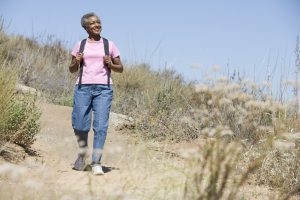Falls are a serious problem among older adults. Approximately one in every four people over age 65 fall each year, and 20 percent of those lead to a serious injury such as a broken bone or head injury. Falls are the most common reason that older adults are admitted to the hospital.
Older adults are more likely to fall for a variety of reasons. Aging can lead to weaker muscles and poorer balance. Older adults are less likely to see or notice tripping hazards, such as throw rugs and sidewalk cracks. Some chronic illnesses among the elderly lead to problems in the legs and feet that make it more likely for them to fall. And some medications cause light headedness or dizziness that can lead to a fall.
What’s the best course of action to prevent older adults from falling? The U.S. Preventative Services Task Force published a systematic review this month to answer that question.
The review, published in the Journal of the American Medical Association, identified 62 randomized controlled trials that looked at how well three types of interventions helped to prevent falls: vitamin D supplements, exercise, and a multi-pronged approach based on each participant’s risk factors.
Twenty-six studies examined the multi-pronged approach. This type of intervention focuses on participants’ health history to develop fall prevention plans that could include exercise, cognitive behavioral therapy, education about falls, medication management, urinary incontinence management, changes to their environments, and referrals to occupational and physical therapy.
In the studies included in this review, researchers followed the participants for six to 36 months. The analysis found that although older adults who used this approach were less likely to fall, the approach did not reduce the likelihood of becoming injured in a fall.
Twenty-one studies looked at whether exercise including balance work, gait practice, and functional training could reduce the likelihood of older adults falling. The studies followed participants from six months up to five years. The analysis found that exercise programs significantly reduced the likelihood of falling and the likelihood of being injured by a fall.
Seven studies investigated whether taking vitamin D helped to reduce the risk of falls by following participants for nine months up to 5 years. The researchers’ analysis found no statistically-significant evidence that taking vitamin D reduced the risk of falling or becoming injured by a fall. It’s important to note that researchers only included studies where participants did not have a vitamin D deficiency.
The take-home message here is clear: The evidence shows that exercise is the best way to prevent older adults from falling and getting injured by falling. Multi-pronged interventions that address a person’s specific risk factors also help to prevent falls, but not as well as exercise. And, for those with normal levels of vitamin D, taking a vitamin D supplement is unlikely to prevent a fall.




Speak Your Mind